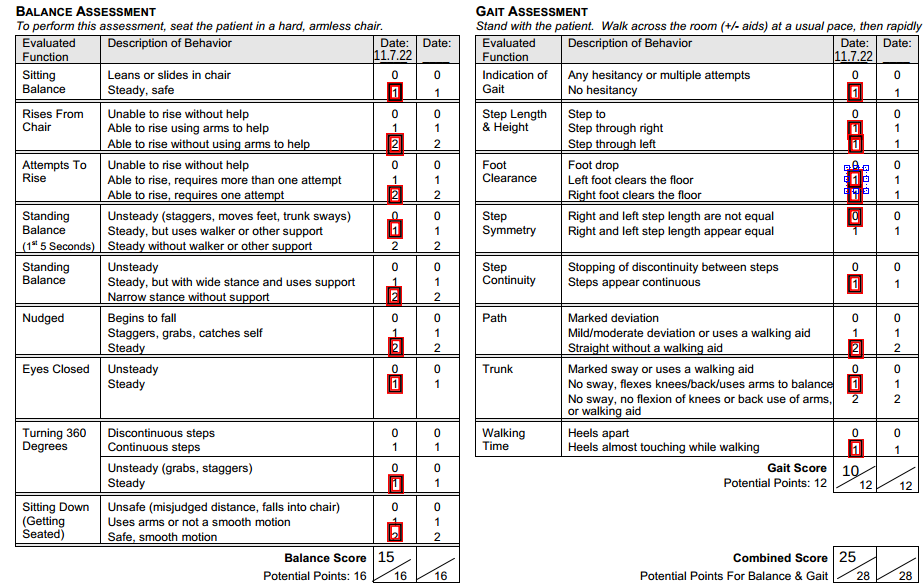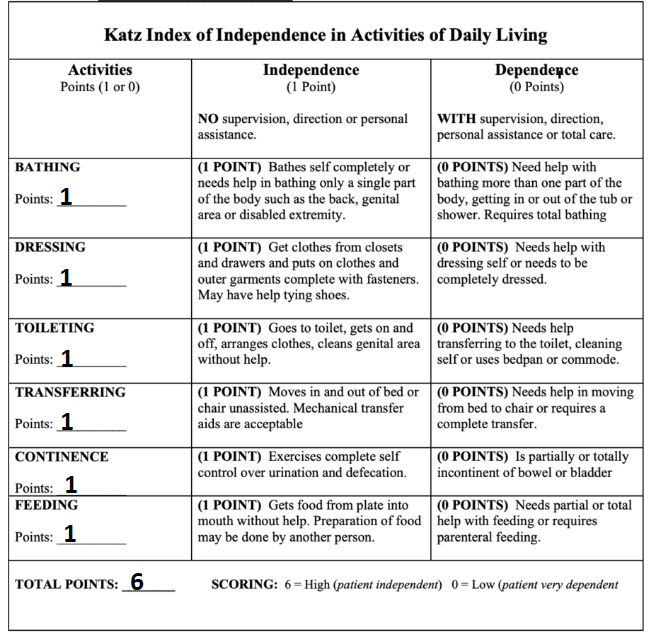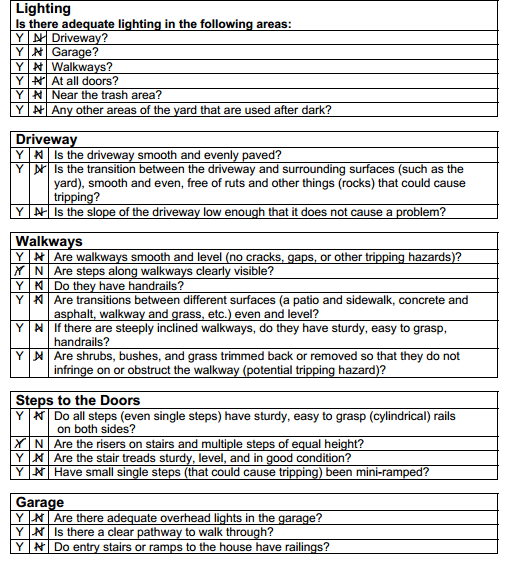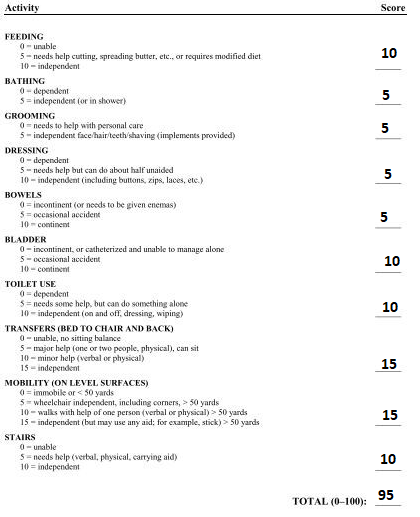As a summary of the patient’s psychosocial interview, emphasis can be placed on the point that he is not a classic case of an elderly care client. John prefers to act independently, has an excellent psychological and physiological condition, and seeks medical help only when necessary. The results of the physical and mental functional assessment will be presented further.
Physical and Mental Functional Assessment: Tinetti Balance and Gait Evaluation
The gait and balance assessment results show good results for the patient and a low risk. No significant age-related deterioration was found on almost all items (Appendix B).
Katz Index of Activities of Daily Living
The older adult under observation has no observable problems in daily living activities at this time (Appendix C; Pashmdarfard & Azad, 2020).
Assessment of Home Safety
The observed elderly person has reached a reasonable level in terms of home space optimization. For himself and his wife, the patient has organized his living and interior space efficiently (Appendix D).
The Barthel Index
The Barthel Index is based on interviews with the patient, his relatives, and observation (Bouwstra et al., 2019). The results for the observed age are quite high, though with some downward tendency (Appendix E).
Preliminary Issues
The changes associated with the aging process are identified as having standard deviations within acceptable limits. The main problems are delayed reactions, impaired coordination, impaired hearing, progressive visual impairment, and arthritis.
Alterations in Health
- A thorough examination of the patient’s joints is necessary to identify potential problems.
- Recommend further ophthalmologic evaluation and prescription of glasses – signs of visual impairment and slight disorientation are noted.
- Among other things, supplementation with special vitamin supplements for the elderly is recommended for maintaining a healthy body.
Comprehensive Interventions for Each Alteration
- In the case of problems with the knee joint, surgery may be necessary, after which the patient should be given a cane.
- Temporary walking with an assistive device will be recommended to reduce the joint load, even without surgery.
- Increased calcium and other essential nutrients may be recommended.
- Decrease in the physical activity for the period of health evaluation.
- Prescription of glasses for progressive hyperopia.
- Exercise to maintain vision at an adequate level.
- The patient should be encouraged to reduce the strain on vision.
- Reducing physical activity.
- Switching to a special set of exercises instead of the general one not intended for the elderly.
- Reconsideration of the entire diet in order to decrease the burden on the body.
Cultural Considerations
No additional cultural considerations are needed when recommending a patient. He demonstrates a remarkable high and responsive level of mental flexibility and listens to recommendations while prejudice is not noticed. However, given the firmness of character and some stubbornness, it is recommended that when making changes in the patient’s diet or physical activity, the relatives be asked to monitor compliance.
References
Anwari, C., Balasubramanian, S., Sawant, P., Kuri, U., Anand, A., Rao, B. C., & Prasad, R. (2022). Elder care: The need for interprofessional collaboration between Family Physicians, Clinical Pharmacists, and Physiotherapists in home-based primary care teams. Journal of Family Medicine and Primary Care, 11(9), 5170. Web.
Bouwstra, H., Smit, E. B., Wattel, E. M., van der Wouden, J. C., Hertogh, C. M. P. M., Terluin, B., & Terwee, C. B. (2019). Measurement properties of the Barthel index in geriatric rehabilitation. Journal of the American Medical Directors Association, 20(4), 420-425.e1. Web.
Kim, Han-Som, Choi, Seong-Youl, Lee, Hye-Sun, Han, & Sang-Woo. (2021). Development of a Korea-specific home safety assessment tool for the elderly. Annals of the Romanian Society for Cell Biology, 25(6), 20521–20539. Web.
Naczk, M., Marszalek, S., & Naczk, A. (2020). Inertial training improves strength, balance, and gait speed in elderly nursing home residents. Clinical Interventions in Aging, 15, 177–184. Web.
Pashmdarfard, M., & Azad, A. (2020). Assessment tools to evaluate Activities of Daily Living (ADL) and Instrumental Activities of Daily Living (IADL) in older adults: A systematic review. Medical Journal of the Islamic Republic of Iran, 34, 33. Web.
Appendix
Patient Questionnaire
Interview of Chosen Elder Adult
Name: John Smith__ Age: 74
Brief Introduction (Background information):
White male, shows apparent signs of aging but is in good physical shape. He does not complain of any chronic diseases or pathologies, although he noticeably limps on his left leg, which is a possible consequence of arthritis. Does not show any signs of dementia during the interview and speaks confidently and clearly.
- Philosophy on living a long life
- According to the patient, the key to a long life is plenty of physical activity, a healthy diet, and good family relationships with minimization of stress.
- Thoughts about when a person is considered “too old”
- A person becomes too old only when he or she begins to think this way and allows others to form this opinion. As long as there is zeal and interest in life, there is no old age of the mind.
- Opinion on the status and treatment of older adults
- He approves of respect for the elderly generation but complains about not always optimal conditions for older adults in public places. On the other hand, he speaks negatively of his peers, who put themselves above others and despise the younger generation.
- Beliefs about health and illness
- In the patient’s opinion, health largely depends on self-confidence and belief. If one is weak in spirit, one will fall ill often and will not live long.
- Health promotion activities he or she participates in
- He regularly participates in charity marathons, where he runs as long as he can without exaggerating his own strength. On weekends, he performs physical exercises for the elderly from the social center in a nearby park.
- Something special that helped the person live so long
- He attributed his good health and longevity to his wife, with whom he claims to have been married for over 50 years, with almost no conflicts.
- Life span of other family members
- According to the patient, his parents have lived for almost 90 years and instilled in him a love of life and work. He is an only child in the family, and his immediate family is younger than him and alive.
- Special dietary traditions in patient’s culture attributed with aiding long life
- The patient does not follow specific diets but tries to consume as much protein as possible. He is not culturally specific but believes that the role of the male hunter in the family is essential and has taught all of his children and grandchildren to eat plenty of meat and fresh vegetables.
- Any remedies/medications that have been handed down in family/group. If yes, describe.
- Taking specific medications in his family is not confirmed.
- Patient’s description of current and past health status
- During the conversation, he confirmed the pain in his knee, which had been bothering him for the past few years. He had previously experienced a mild form of coronavirus infection and did not report any severe illnesses.
- The values that guided life so far
- Dedication to the wife and family, honesty with everyone, especially himself, and confidence in the rightness of his actions, whatever they may be.
Additional Questions
- Why didn’t the patient go to the doctor if he felt pain in his knee?
- It is not a matter of mistrust but a matter of lack of time. For the most part, it only gives the patient a little discomfort and does not interfere with living a reasonably active lifestyle for their age.
- Are there any problems with socialization among peers?
- He does not have any problems with socialization but prefers not to socialize with those who are “completely aging out” or with those who are jealous and dislike youth.
- Does the patient have any problems with the younger generation?
- The patient continues to work in retail and has his own small business. All his employees are much younger than him, and according to him, they make him feel young. He prefers the company of his young subordinates, children, and grandchildren to that of people his age.
Summary
The patient is very self-confident and is accustomed to not showing weakness. Despite the shortness of breath and visual signs of aging, his mental state is in satisfactory condition. Food preferences and physical activity confirm the excellent condition of the body for this age.
Contrast of client’s responses with findings in current literature:
- He does not exaggerate his illnesses and does not try to evoke pity, which may often be noticed among patients of his age (Kim et al., 2021)
- Prefers the company of young people (Anwari et al., 2022)
- The patient has a good Body Mass Index: 25 kg/m2 (Naczk et al., 2020).
Tinetti Balance and Gait Evaluation

Katz Index of Activities of Daily Living

Assessment of Home Safety

The Barthel Index
